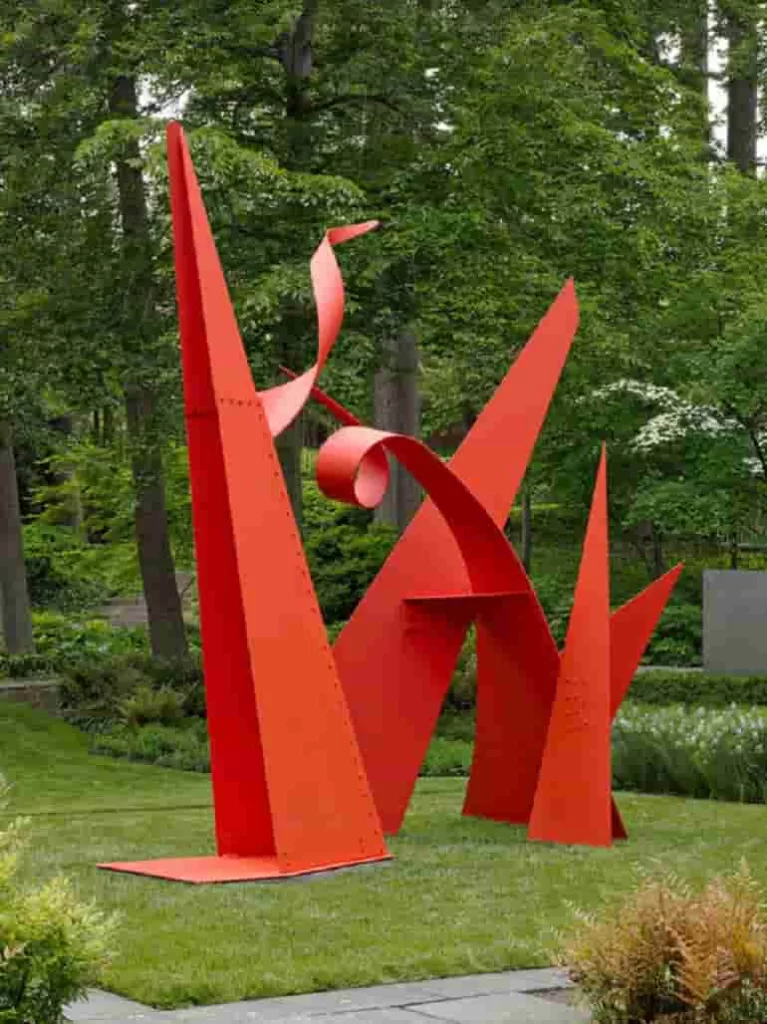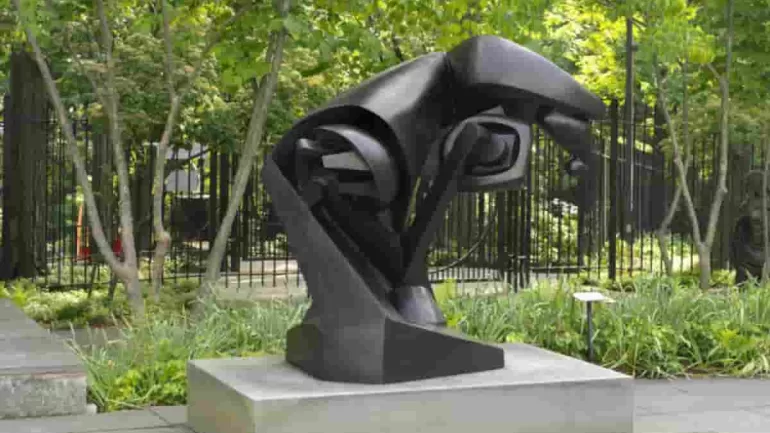MUSEUMS
The Horse by French artist Raymond Duchamp-Villon is one of the works in the Baltimore Museum of Art Sculpture Garden. Image BMA
The Baltimore Museum of Art Sculpture Garden showcases stunning works by artists like Calder, Rodin, and Noguchi. Learn more about this outdoor art oasis.
BY KAZEEM ADELEKE, ARTCENTRON
BALTIMORE, MARYLAND —The Baltimore Museum of Art Sculpture Garden is one of the city’s most treasured cultural landmarks, offering a stunning and unique outdoor exhibition of modern and contemporary sculpture. With a rich history, two beautifully designed sculpture gardens, and works by iconic artists, it is a vibrant hub for visitors to enjoy art in an open-air setting. This comprehensive guide is for those considering a visit, exploring the gardens’ key features, iconic sculptures, and tips for an enriching experience. So, whether you’re a casual visitor or a serious art enthusiast, here is everything you need to know to make the most of your trip to the Baltimore Museum of Art Sculpture Garden.
Overview of the Baltimore Museum of Art Sculpture Garden
Located adjacent to the Baltimore Museum of Art (BMA) itself, the Sculpture Garden is made up of two distinct areas: the Alan and Janet Wurtzburger Sculpture Garden and the Ryda and Robert H. Levi Sculpture Garden. These gardens house an impressive collection of sculptures from the 20th and 21st centuries, featuring works by some of the most prominent artists in modern and contemporary art.
Alan and Janet Wurtzburger Sculpture Garden
The Alan and Janet Wurtzburger Sculpture Garden is a 17,000-square-foot outdoor space designed by George E. Patton, which opened to the public in 1980. This garden marks the beginning of your sculpture garden experience, featuring 19 sculptures by celebrated modernist artists. The Wurtzburger Sculpture Garden is renowned for its diverse collection that showcases both large- and small-scale sculptures. It serves as a testament to the evolution of modern art, with works that reflect the artistic innovations of the early 20th century.
Some of the iconic pieces you can encounter in this garden include works by:
- Alexander Calder: Known for his kinetic sculptures and mobiles, Calder’s works invite visitors to observe the movement within static art.
- Jacques Lipchitz: A Cubist sculptor who brought the principles of abstraction to monumental works, Lipchitz’s sculptures are both intricate and imposing.
- Isamu Noguchi: A celebrated American-Japanese artist whose work blends modernist sculpture with organic forms and architectural elements.
- Auguste Rodin: One of the most famous sculptors in history. Rodin’s works have been in exhibitions worldwide, and The Thinker is a standout example of his monumental legacy.
A stone terrace and a picturesque fountain welcome visitors to the garden. They provide a serene backdrop for these modernist masterpieces. As you walk through the Wurtzburger Garden, you’ll encounter dynamic sculptures that encourage visitors to interact with the environment intimately and reflectively.
Inside the Baltimore Museum of Art Sculpture Garden

Ryda and Robert H. Levi Sculpture Garden
Just below the Alan and Janet Wurtzburger Sculpture Garden lies the Ryda and Robert H. Levi Sculpture Garden, a two-acre space that opened to the public in 1988. Designed by Sasaki Associates, this garden features a stunning collection of sculptures from the latter half of the 20th century. It offers a different atmosphere than the Wurtzburger Sculpture Garden, focusing on postmodern and contemporary art.
Key highlights of the Levi Sculpture Garden include works by artists such as:
- Anthony Caro: Renowned for his innovative use of steel and his exploration of abstract, geometric forms, Caro’s works push the boundaries of what sculpture can represent.
- Joan Miró: Famous for his surrealist approach, Miró’s work in the Levi Sculpture Garden exemplifies his characteristic use of vibrant colors, abstract shapes, and whimsical imagery.
- Louise Nevelson: She is known for her large, monochromatic wooden sculptures. Nevelson’s work is a striking presence in the garden, often evoking themes of space, geometry, and memory.
- Tony Smith: A leading figure in the post-World War II American art scene. Smith’s large-scale sculptures are often geometric and minimalist in design. Their size makes them a dramatic focal point in the garden.
The Levi Sculpture Garden offers visitors a chance to experience the dynamic shift in sculpture from the mid-century to the present. This opportunity makes it an essential stop for anyone interested in contemporary art.
Tips for Visiting the Baltimore Museum of Art Sculpture Garden
As a first-time visitor or a regular art lover, these tips can enhance your experience in the Baltimore Museum of Art Sculpture Garden.
1. Check the Opening Hours
The Alan and Janet Wurtzburger Sculpture Garden and the Ryda and Robert H. Levi Sculpture Garden are free and open to the public year-round from Wednesday to Sunday, 10 a.m. to 5 p.m., weather permitting. It’s always a good idea to check for any schedule changes before you visit the gardens because storms or extreme temperatures can lead to closures. You can call for any up-to-date information.
2. No Reservations Needed
Visiting the gardens does not require reservations. Simply arrive during operating hours, and you’re free to explore at your own pace.
3. Be Prepared for Weather
The gardens are outdoors, and weather conditions can impact your experience. Be sure to wear comfortable shoes for walking, and check the forecast ahead of time. The garden may close during inclement weather, so plan your visit accordingly.
4. Engage with the Art
The beauty of the Baltimore Museum of Art Sculpture Garden lies in its blend of art and nature. Take your time to walk along the paths and linger by the sculptures for an up-close look at these fascinating pieces of art. Many of these sculptures invite contemplation and reflection, so make sure to take in their details.
5. Attend Special Events
The Baltimore Museum of Art Sculpture Garden often hosts special events, such as the Jazz in the Sculpture Garden series. This event features live performances from renowned jazz musicians. If you’re visiting in the summer, be sure to check the calendar for upcoming performances.
6. Plan for Accessibility
Both sculpture gardens are wheelchair accessible, so everyone can enjoy the outdoor exhibits.
Iconic Pieces in the Sculpture Garden
While every piece in the garden is significant, certain sculptures have become iconic over time. Here are a few that you should not miss:
- Alexander Calder’s Mobile in the Wurtzburger Sculpture Garden offers a stunning display of movement and color. Calder’s mobiles are well-known for their delicate balance and kinetic energy, captivating viewers as they sway in the breeze.
- Isamu Noguchi’s Black Sun in the Wurtzburger Sculpture Garden is a monumental stone piece with great presence. It evokes both simplicity and complexity in its form.
- Tony Smith’s Smoke in the Levi Sculpture Garden challenges visitors with its minimalism. This powerful structure also plays with perception and space.
What You Need to Know Before Visiting
Before you visit the Baltimore Museum of Art Sculpture Garden, it’s essential to review the museum’s visitor policies. Reviewing these policies helps ensure a smooth and enjoyable experience. The garden is open year-round, but it may close during adverse weather conditions, including storms or extreme temperatures. Contact the museum for updates. Additionally, there is no charge for admission to the sculpture gardens. With free admission, you can visit as often as you like.
Experience the Baltimore Museum of Art Sculpture Garden
The Baltimore Museum of Art Sculpture Garden offers an incredible opportunity to experience modern and contemporary sculpture in a serene and accessible setting. If you love the early modernist works of the Wurtzburger Sculpture Garden or the more recent pieces in the Levi Sculpture Garden, there’s something for every art lover to enjoy. Plan your visit accordingly and engage with the art around you. Take your time to appreciate the thoughtful design of both gardens. No matter your level of experience, the sculpture garden is sure to provide an enriching experience.
